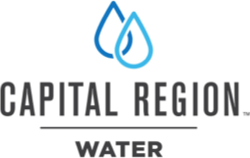Operators of a small MS4 must obtain an NPDES permit and develop and implement a stormwater management plan (SWMP) according to the details of their specific permit. Mandatory elements of the SWMP include six (6) Minimum Control Measures (MCMs) – use the tabs to explore each one below.
Capital Region Water is committed to implementing a public education and outreach program that ensures compliance with MCM #1 under the MS4 permit, specifically to build greater support for the City Beautiful H2O Program, increase compliance, and ultimately improve environmental awareness throughout the community.
Information and outreach will be provided on a continuous basis to ensure that residents within Capital Region Water’s service territory are provided various avenues to access information about stormwater pollution and their role in reducing and preventing it.
In order to achieve the goal of limiting the amount of pollution entering our waterways within Capital Region Water’s service territory through the separate storm sewer system, education and outreach will be paramount.
The Public Involvement and Participation Program Plan, in cooperation with the ongoing education and outreach initiatives of the City Beautiful H2O Program, is intended to comply with MCM#2 of the Stormwater Management Program as specified in Part C of Capital Region Water’s permit.
Capital Region Water is committed to updating and maintaining a list of target audiences served by the MS4 system as well as audiences more broadly served by Capital Region Water’s stormwater system in the City of Harrisburg to ensure compliance with MCM #2.
A comprehensive stakeholder list has been maintained since 2017. This list is reviewed and revised on an ongoing basis and no less than annually. Capital Region Water also attempts to track meeting dates/times as well as a record of outreach dates.
Additional Resources:
Stormwater Management-Main (dauphincd.org)
Pennsylvania DEP (pa.gov)
Pennsylvania DEP (pa.gov)
Stormwater Phase II Final Rule: Public Education and Outreach Minimum Control Measure (epa.gov)
The goal of the Illicit Discharge Detection and Elimination MCM is to reduce pollution to our waterways through the removal of non-stormwater contributions to the storm sewer system. Common sources of illicit discharges include any discharge into a storm drain system that is not entirely composed of stormwater. Illicit discharges are a problem because, unlike wastewater which flows to a treatment plant, stormwater generally flows directly to waterways without any treatment. This means all the pollutants located within the water flow directly into the water we then consume. Illicit discharges often contain pathogens, nutrients, sediment, and various toxic pollutants, such as heavy metals.
Capital Region Water has an online portal for reporting illicit dumping and discharge, if you see anyone engaging in these types of activities please detail your findings on our website at: Report Illicit Discharge
The goal of the Construction Site Runoff Control MCM is to protect our waterways from stormwater-related pollution that can result from construction activities.
Uncontrolled stormwater runoff from construction sites can significantly impact the stream system. Sediment in waterbodies from construction sites can reduce the amount of sunlight reaching aquatic plants, clog fish gills, smother aquatic habitat and spawning areas, and impede navigation.
Additional Resources:
Stormwater and the Construction Industry
DCCD Landowner Information
Construction Site Stormwater Runoff Control Fact Sheet
Stormwater Discharges from Construction Activities
Construction Stormwater Inspection Guide NY
Stormwater Construction Inspection Guide
The goal of the Post-Construction Runoff Control MCM is to avoid increased stormwater runoff problems and increased non-point source pollution that often accompanies the development of land and the associated increases in impervious surfaces.
Capital Region Water has a Memorandum of Understanding with Dauphin County Conservation District, Dauphin County, and the City of Harrisburg for the purpose of coordinating, where possible and desirable, the activities of the Authority and the District associated with MS4 permit requirements. While not all requirements lend themselves to coordination, several of the requirements are such that coordination will result in decreased compliance costs and greater efficiency for both the Authority and the county.
Additional Resources:
Stormwater Phase II Final Rule: Post-Construction Runoff Control Minimum Control Measure (epa.gov)
To prevent pollutants from entering the surrounding waterways Capital Region Water implemented an Operations and Maintenance (O&M) Program This program includes training components for employees of CRW and proper O&M of facilities. CRW focuses on preventing pollution before it happens at all the company-owned facilities and green stormwater infrastructure.
Municipal activities such as winter road maintenance, minor road repairs, and other infrastructure work, automobile fleet maintenance, landscaping and park maintenance, and building maintenance can release pollutants into MS4s that ultimately discharge to nearby waterbodies. Municipal facilities can also be sources of stormwater pollutants if BMPs are not in place to contain spills, manage trash, and handle non-stormwater discharges. Sweeping parking lots, streets, and cleaning storm drains can prevent pollutants at the source from entering nearby waterways.
Additional Resources:
Stormwater Phase II Final Rule: Pollution Prevention/Good Housekeeping Minimum Control Measure (epa.gov)
[MAP]
Learn more through these State/County/Federal Links:
